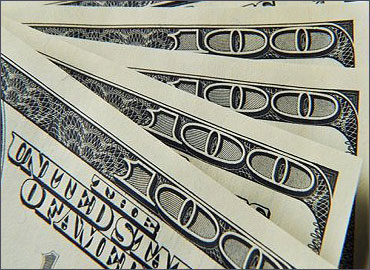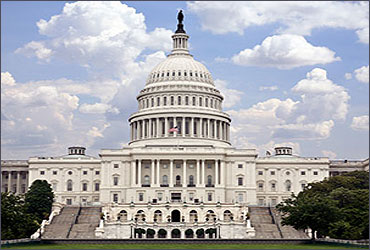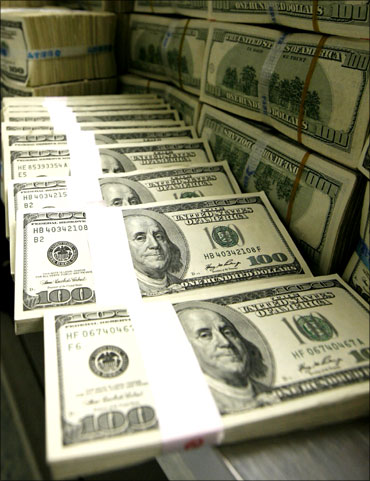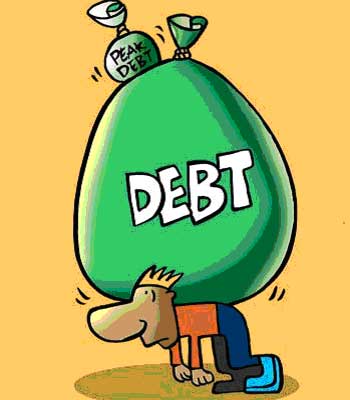Photographs: Reuters Shonalee Biswas
"Debt is a four-letter word," my roommate said early in the morning, still wondering what had made her run up such a huge credit card bill. "I am so glad that you helped me pay back my credit card dues, otherwise I would have been in one big mess."
"Yeah, it sure is a bad word, unless you are the United States of America," I replied.
"How is it different for the USA?"
"Reminds me of that great line from The Godfather, 'I'll make him an offer he can't refuse',"
"So tell me."
"As we have discussed in the past, on August 5, 2011, Standard and Poor's, one of the big three rating agencies downgraded the US government debt from 'AAA' rating to 'AA+' rating. This basically meant that financial securities called bonds issued by the US government to finance its fiscal deficit were no longer in the safest category. Fiscal deficit is the difference between what a government earns and what it spends."
"Yeah, I remember that. AAA rating is the best rating possible on a bond, and is currently enjoyed by only 16 countries."
. . .
The trillion-dollar question nobody can answer
Photographs: Reuters
"Yes, I remember reading a few lines in the report issued by the rating agency on the reasons behind the downgrade and it basically said: 'The political brinksmanship of recent months highlights what we see as America's governance and policymaking becoming less stable, less effective, and less predictable than what we previously believed. Our opinion is that elected officials remain wary of tackling the structural issues required to effectively address the rising US public debt burden in a manner consistent with a 'AAA' rating and with 'AAA' rated sovereign peers'," I quoted.
"Whoa! What was that?" she asked.
"What the rating agency meant was that it no longer trusts the ability of the US government to repay the debt it had taken on by issuing bonds," I told her.
"And that's why the downgrade, to show that the riskiness of US government bonds has gone up?"
"Yes."
"So what is the issue then?"
"Well, after the downgrade a rather funny thing happened."
"Funny thing?"
. . .
The trillion-dollar question nobody can answer
Photographs: Reuters
"Now what should have happened after this downgrade?" I asked.
"At a theoretical level, some of the investors who had bought these bonds should have sold these bonds because their 'supposed' riskiness went up after the downgrade."
"Yeah, right. But exactly the opposite thing happened. Investors went ahead and bought these bonds, instead of selling them."
"But why would they something as 'daft' as that?"
"The purported reason is that investors are fleeing to the safety of the US as there are bigger debt issues in Europe."
"Safety of the US?"
"That's the thinking at work. They feel that the situation in the US is not as bad as it is in Europe."
. . .
The trillion-dollar question nobody can answer
Photographs: Reuters
"But it is bad nevertheless. I mean last time you told me that the US debt to gross domestic product ratio was almost 100%. This doesn't make sense."
"Yes, it doesn't. Let me ask a question: If the debt is riskier what does the issuer of debt have to do to make it more attractive?" I asked.
"Offer a greater rate of return on it."
"Yeah. But exactly the opposite is happening when it comes to US government bonds. The return on a 10-year bond before the downgrade stood at 2.5%, but now the return has gone under 2% as more and more investors are rushing to the 'supposed' safety of the US government debt. Frankly this does not make sense."
"Yes."
"In fact, there is something that makes the situation worse. The US dollar is losing value against other currencies, making the situation bad for foreign investors buying US government debt."
"Can you explain this a little more?"
. . .
The trillion-dollar question nobody can answer
Photographs: Reuters
"Sure. Let us take the case of China. At the beginning of year one US dollar was worth 6.6 Yuan. Now, one dollar is worth 6.4 yuan. So let us say at the beginning of the year China invested a million dollars in US government bonds. One million dollars would mean 6.6 million Yuan (1million x 6.6). Let us say on this investment a return of 2% is earned till now. So the million dollar investment now becomes $1.02 million Yuan. Now how much do you get when you convert this into Yuan?" I asked.
"You tell me. You are the mathematician."
"Well, you multiply $1.02 million by the current exchange rate, i.e. 6.4. So you get 6.53 million Yuan. Now how much had you invested?"
"6.6 million Yuan."
"So even though you made money in dollar terms, in Yuan terms you lost money because the dollar has lost value against the Yuan in the meanwhile," I explained.
"Now that's interesting."
. . .
The trillion-dollar question nobody can answer
Photographs: Reuters
"Since the investment bank Lehman Brothers went bust the US has printed nearly $2.3 trillion in order to first rescue banks and insurance companies like Citibank and AIG and then revive a moribund US economy."
"So?"
"Well as a simple understanding of economics will tell you, when you flood anything into any market it tends to lose value against other things and vice versa. So the dollar has been falling in value against other currencies. As Harvard economist Martin Feldstein, wrote in a recent research paper titled What's Next for the Dollar, 'The real trade weighted value of the dollar fell 11 percent against the Federal Reserve Bank's index of major currencies during the 12 months through May 2011 and 31 percent during the past ten years'."
"Hmm... So why are international investors still investing in the US government debt, despite low returns or even negative returns in some cases?" she interrupted.
"The answer lies in the US trade deficit."
"Eh?" she interrupted again.
"Trade deficit at a very basic level is the difference between what a country buys from foreigners and what they have sold to foreigners, i.e. imports minus exports. In the case of the US this number adds up to nearly $8 trillion over the last forty years. Even now the trade deficit is still growing by around $50 billion per month."
"What has this got to do with my question?"
. . .
The trillion-dollar question nobody can answer
Photographs: Reuters
"Here is how it works. The US buys stuff from other countries. This means that these countries get paid dollars for it. This money finds it ways back into the US. Countries which have earned these dollars use it to buy bonds issued by the US government. This money coming back ensures that the US can continue buying goods and services from these countries. And so these countries are ready to buy US government bonds, even though they are risky because the money keeps coming back to them."
"Hmmm. So it's like I scratch your back and you scratch mine," she remarked.
"Yeah that's the best way to look at it. And that at some level explains the dichotomy. Despite the riskiness of US government debt increasing, foreign investors are more than happy to invest in it. So, what we have here is a bond market bubble in the US."
"Why do you call it a bubble?"
. . .
The trillion-dollar question nobody can answer
"Because it is not sustainable. The United States government over the years has been spending more than what it earns. Like for the year 2011, the expected revenues for the US government stand at $2.17 trillion, whereas the expected expenditure is much higher at $3.82 trillion, leaving a difference of $1.65 trillion between what the government earns and spends. This difference is partly met through selling bonds to investors. The rest is met through printing money. Over the years the US government debt has accumulated to around $14.3 trillion," I explained.
"So how will they repay the debt?"
"They can't. Technically you can repay your debt when you save something, when your income is greater than your expenditure. Otherwise the only way out is to issue fresh bonds and use the money raised to payback maturing bonds. And that's what is happening currently. The new debt being issued is being used to pay off old maturing debt. Also, on August 1, 2011, the US government approved the raising of an extra $2.1 trillion of debt, over the next few years. So they don't seem to be in any mood to cut down on their debt."
"And when will this bubble burst?"
"That is the trillion-dollar question which no one has an answer to. As the famous economist John Maynard Keynes said, 'Markets can remain irrational longer than you can remain solvent'."
The author can be reached at shonalee.biswas@rediffmail.com









article